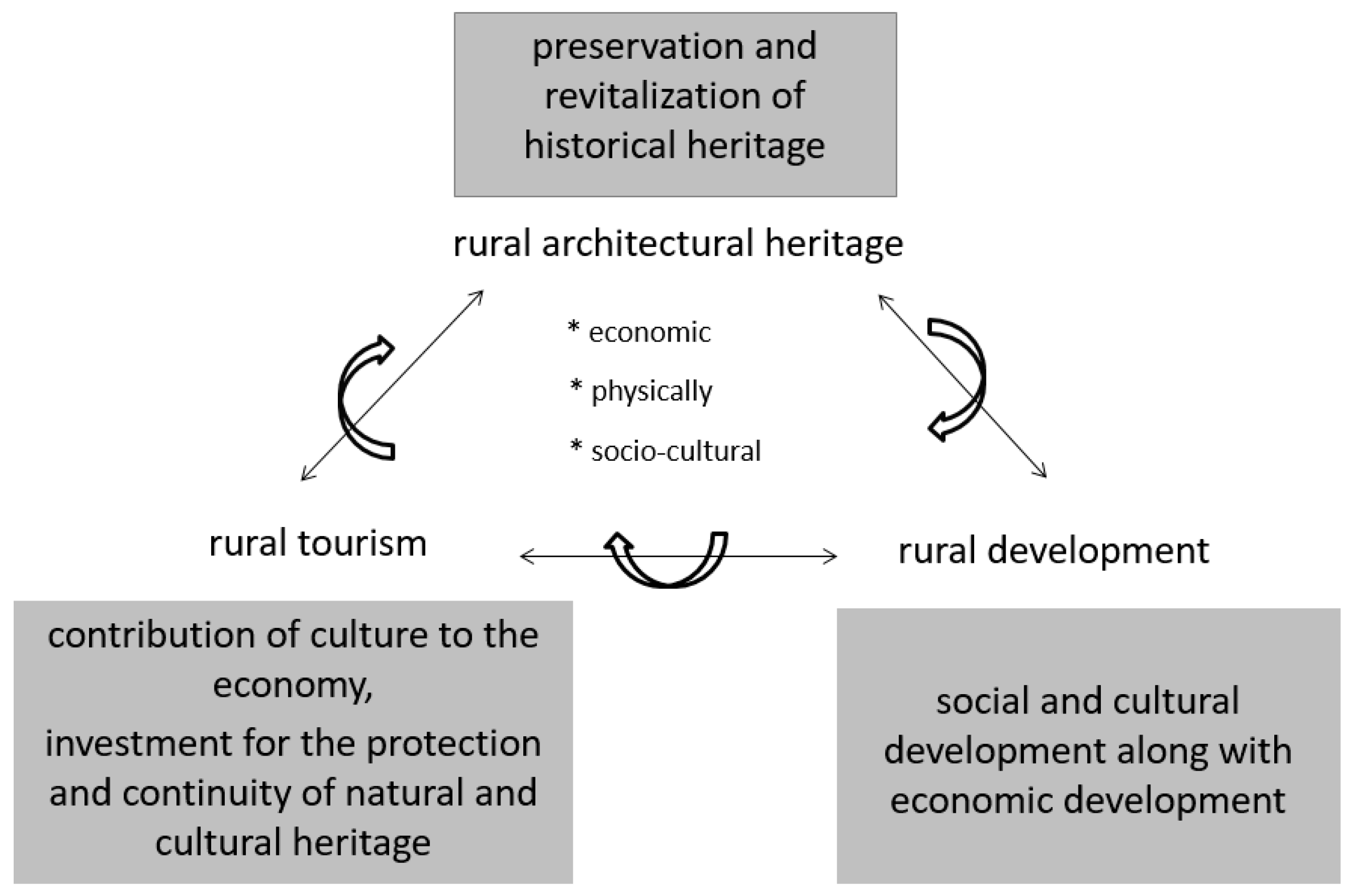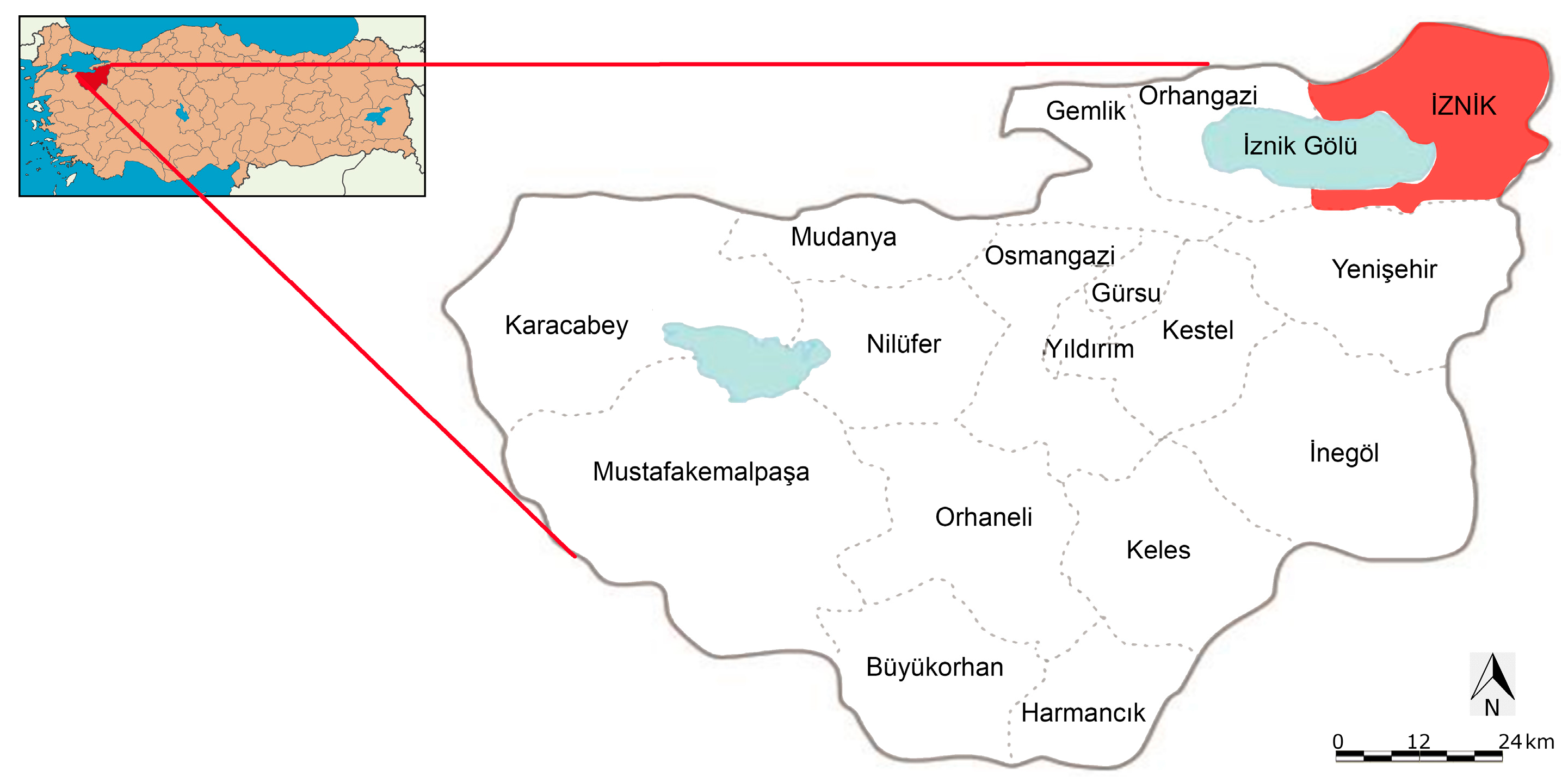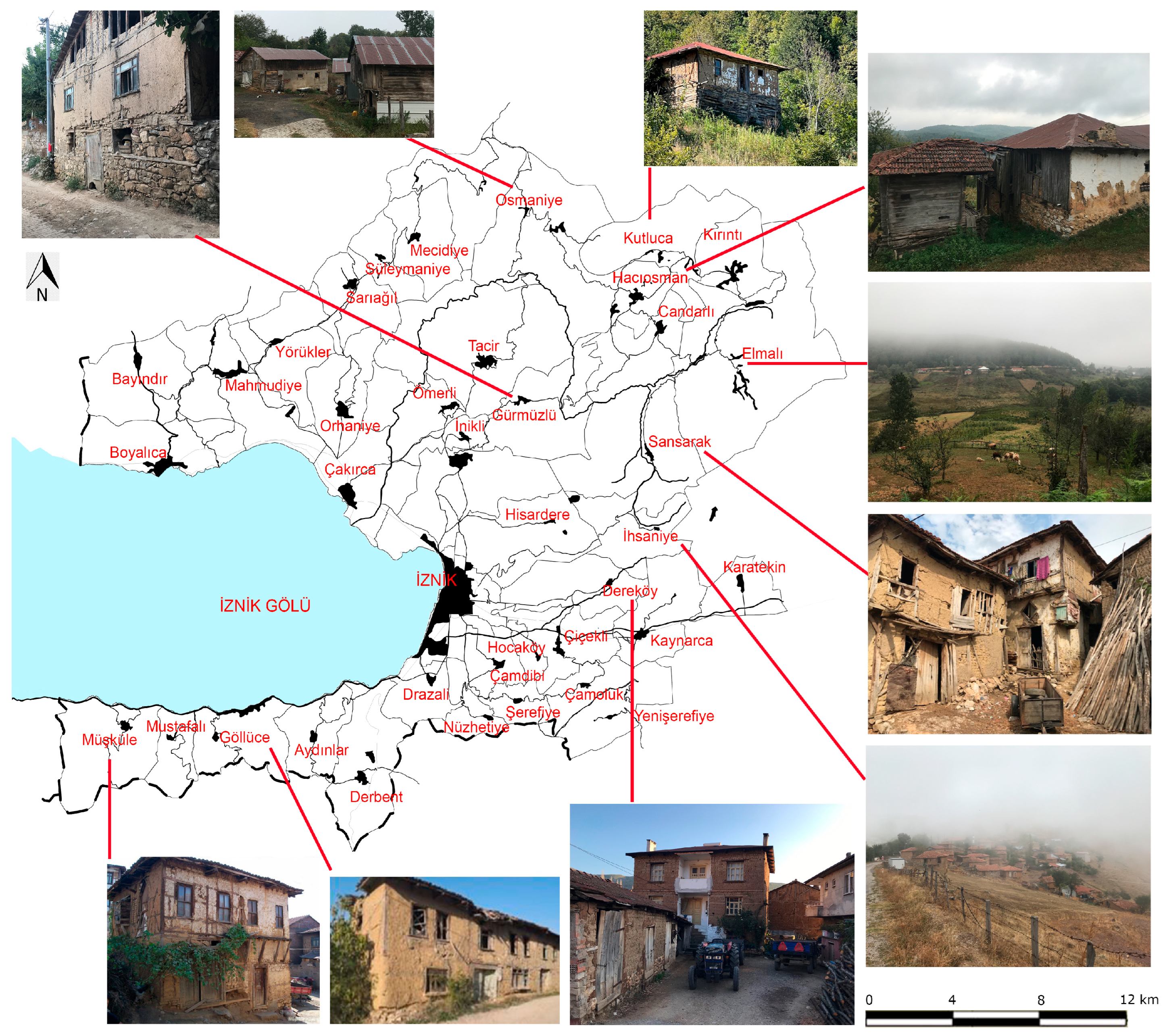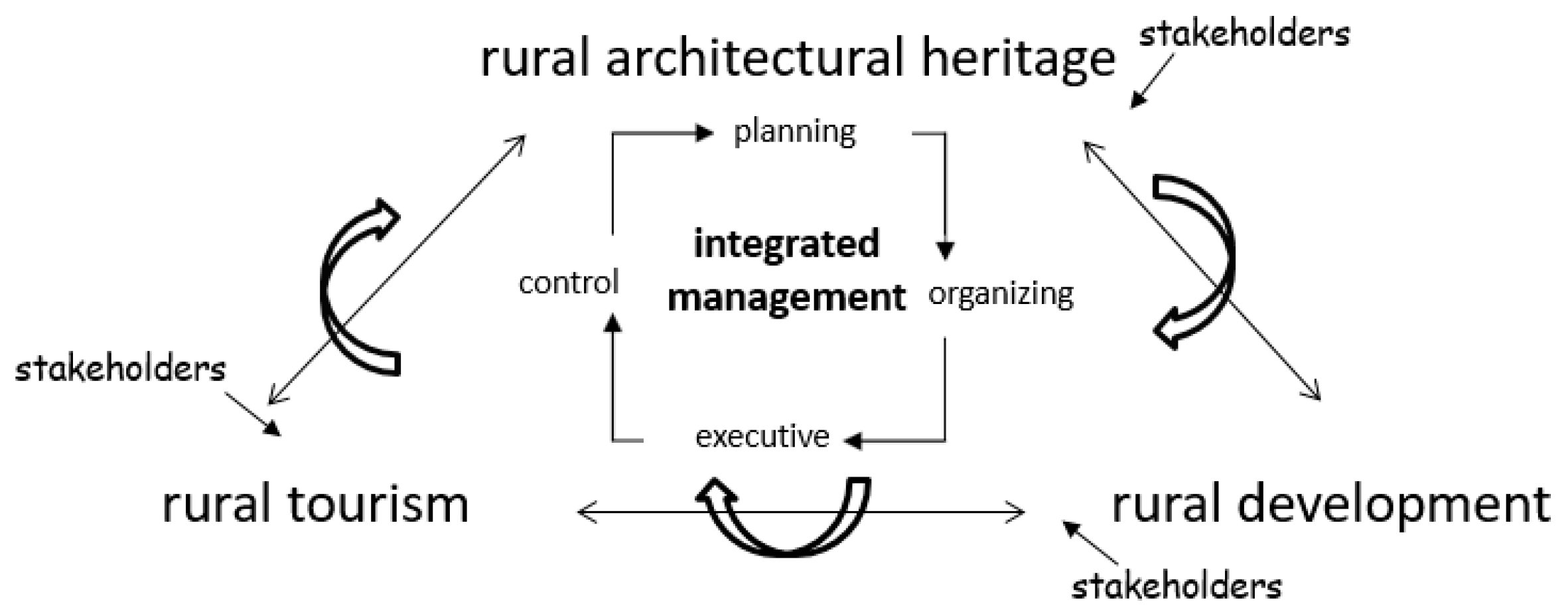Sustainable Management of Rural Architectural Heritage Through Rural Tourism: Iznik (Turkey) Case Study
Abstract
1. Introduction
2. Literature Review
2.1. Relationship Between Rural Architectural Heritage, Rural Tourism, and Rural Development
2.2. Rural Tourism and Cultural Heritage Management in the Sustainability of Rural Areas
3. Materials and Methods
3.1. The Iznik Rural Area
3.2. Methodology
4. Results
4.1. Field Study Conducted in Rural Areas
4.2. Stakeholder Interviews
4.3. Findings and Recommendations
5. Discussion
6. Conclusions
Author Contributions
Funding
Institutional Review Board Statement
Informed Consent Statement
Data Availability Statement
Acknowledgments
Conflicts of Interest
References
- Quintana, D.C.; Díaz-Puente, J.M.; Gallego-Moreno, F. Architectural and cultural heritage as a driver of social change in rural areas: 10 years (2009–2019) of management and recovery in Huete, a town of Cuenca, Spain. Land Use Policy 2022, 115, 106017. [Google Scholar] [CrossRef]
- Carneiro, M.J.; Lima, J.; Silva, A.L. Landscape and the rural tourism experience: Identifying key elements, addressing potential, and implications for the future. J. Sustain. Tour. 2015, 23, 1217–1235. [Google Scholar] [CrossRef]
- Soykök Ede, B.; Taş, M.; Taş, N. UNESCO Dünya Miras Süreci üzerinden İznik kırsal endüstri mimari mirasının sürdürülebilir korunması, yaşatılması ve canlandırılması. In Disiplinlerarası Yaklaşımlarla Kırsal Endüstri Mirası; Baykal, F., Karadağ, A., Eds.; Ege Üniversitesi Yayınları: İzmir, Türkiye, 2023; pp. 75–95. Available online: https://www.researchgate.net/publication/380632354_UNESCO_DUNYA_MIRAS_SURECI_UZERINDEN_IZNIK_KIRSAL_ENDUSTRI_MIMARI_MIRASININ_SURDURULEBILIR_KORUNMASI_YASATILMASI_VE_CANLANDIRILMASI (accessed on 13 January 2025).
- Harbiankova, A.; Scherbina, E.; Budzevich, M. Exploring the Significance of Heritage Preservationin Enhancing the Settlement System Resilience. Sustainability 2023, 15, 15251. [Google Scholar] [CrossRef]
- MacDonald, D.; Crabtree, J.R.; Wiesinger, G.; Dax, T.; Stamou, N.; Fleury, P.; Gutierrez Lazpita, J.; Gibon, A. Agricultural abandonment in mountain areas of Europe: Environmental consequences and policy response. J. Environ. Manag. 2000, 59, 47–69. [Google Scholar] [CrossRef]
- Güler, K.; Kahya, Y. Developing an approach for conservation of abandoned rural settlements in Turkey. ITU A|Z 2019, 16, 97–115. [Google Scholar] [CrossRef]
- Navarro, M.L.; Pereira, M.H. Rewilding abandoned land-scapes in Europe. Ecosystems 2012, 15, 900–912. [Google Scholar] [CrossRef]
- Muilu, T.; Rusanen, J. Rural young people in regional development the case of Finland in 1970–2000. J. Rural. Stud. 2003, 19, 295–307. [Google Scholar] [CrossRef]
- Amcoff, T.; Westholm, E. Understanding rural change-demography as a key to the future. Futures 2007, 39, 363–379. [Google Scholar] [CrossRef]
- Li, Y.; Westlund, H.; Liu, Y. Why some rural areas decline while some others not: An overview of rural evolution in the World. J. Rural. Stud. 2019, 68, 135–143. [Google Scholar] [CrossRef]
- Soykan, F. Kırsal turizm ve Türkiye turizmi için önemi. Ege Coğrafya Derg. 2003, 12, 1–11. [Google Scholar]
- Timothy, D.J.; Boyd, S.W. Heritage Tourism; Prentice Hall: Harlow, UK, 2003. [Google Scholar]
- Barrientos, F.; Martin, J.; De Luca, C.; Tondelli, S.; Gómez-García-Bermejo, J.; Zalama Casanova, E. Computational methods and rural cultural & natural heritage: A review. J. Cult. Herit. 2021, 49, 250–259. [Google Scholar]
- Ge, W.; Abd Manan, M.S.b. A Review of and Prospect of Village Architecture Research from the Perspective of Rural Tourism. World 2025, 6, 21. [Google Scholar] [CrossRef]
- MacDonald, R.; Jolliffe, L. Cultural rural tourism: Evidence from Canada. Ann. Tour. Res. 2003, 30, 307–322. [Google Scholar] [CrossRef]
- Parlato, M.C.M.; Valenti, F.; Porto, S.M.C. Sustainable Promotion of Traditional Rural Buildings as Built Heritage Attractions: A Heritage Interpretation Methodology Applied in South Italy. Sustainability 2022, 14, 16206. [Google Scholar] [CrossRef]
- Long, P.; Lane, B. Rural Tourism Development. In Trends in Outdoor Recreation, Leisure and Tourism; CAB International: Wallingford, UK, 2000; pp. 299–308. Available online: https://www.researchgate.net/profile/Ingrid-Schneider-3/publication/292016815_Recreation_conflict_management/links/60e31ae1a6fdccb74507b58a/Recreation-conflict-management.pdf#page=321 (accessed on 13 January 2025)ISBN 978-0-85199-403-1.
- Lane, B. What is rural tourism? J. Sustain. Tour. 1994, 2, 7–21. [Google Scholar] [CrossRef]
- Briedenhann, J.; Wickens, E. Tourism routes as a tool for the economic development of rural areas—Vibrant hope or impossible dream? Tour. Manag. 2004, 25, 71–79. [Google Scholar] [CrossRef]
- Ashworth, G.J. Preservation, Conservation and Heritage: Approaches to the Past in the Present through the Built Environment. Asian Anthropol. 2012, 10, 1–18. [Google Scholar] [CrossRef]
- UNESCO. Encouraging Sustainable Cultural Heritage Management. 2023. Available online: https://www.unesco.org/en/fieldoffice/bangkok/clt/sustainable-cultural-heritage-management (accessed on 10 November 2023).
- Available online: https://whc.unesco.org/en/sustainabledevelopment/ (accessed on 9 December 2023).
- ICOMOS. Action Plan: Cultural Heritage and Localizing the UN Sustainable Development Goals (SDGs). 2017. Available online: https://www.icomos.org/images/DOCUMENTS/Secretariat/2017/ICOMOS_Action_Plan_Cult_Heritage_and_Localizing_SDGs_20170721.pdf (accessed on 13 January 2025).
- ICOMOS. Heritage and The Sustainable Development Goals: Policy Guidance for Heritage and Development Actors. 2021. Available online: https://www.icomos.org.tr/Dosyalar/ICOMOSTR_en0542142001619167638.pdf (accessed on 13 January 2025).
- World Tourism Organization and United Nations Development Programme. Tourism and the Sustainable Development Goals—Journey to 2030; UNWTO: Madrid, Spain, 2017. [Google Scholar]
- Available online: https://www.unwto.org/news/unwto-announces-list-of-best-tourism-villages-2021 (accessed on 9 December 2023).
- Su, Y.W.; Lin, H.L. Analysis of international tourist arrivals worldwide: The role of world heritage sites. Tour. Manag. 2014, 40, 46–58. [Google Scholar] [CrossRef]
- Soykan, F. Doğal çevre ve kırsal kültürle bütünleşen bir turizm türü: Kırsal turizm. Anatolia Tur. Araştırmaları Derg. 1999, 10, 67–75. Available online: https://scholar.google.com.tr/citations?view_op=view_citation&hl=tr&user=yJo_3BQAAAAJ&citation_for_view=yJo_3BQAAAAJ:ZeXyd9-uunAC (accessed on 13 January 2025).
- McKercher, B.; Ho, P.; du Crus, H. Relationship between tourism and cultural heritage management: Evidence from Hong Kong. Tour. Manag. 2005, 26, 539–548. [Google Scholar] [CrossRef]
- Buonincontri, P.; Morvillo, A.; Okumus, F.; van Niekerk, M. Managing the experience co-creation process in tourism destinations: Empirical findings from Naples. Tour. Manag. 2017, 62, 264–277. [Google Scholar] [CrossRef]
- Erkal, N. Gösteri olarak mimarlık: Turizmin güncel mimarlığa etkileri üzerine. Mimarlık 2017, 336, 1–3. [Google Scholar]
- Taş, M.; Taş, N.; Çahantimur, A. A participatory governance model for the sustainable development of Cumalikizik, a heritage site in Turkey. Environ. Urban. 2009, 21, 161–184. [Google Scholar] [CrossRef]
- Fuentes, J.M. Methodological bases for documenting and reusing vernacular farm architecture. J. Cult. Herit. 2010, 11, 119–129. [Google Scholar] [CrossRef]
- Amit-Cohen, I.; Sofer, M. Cultural heritage and its economic potential in rural society: The case of the kibbutzim in Israel. Land Use Policy 2016, 57, 368–376. [Google Scholar] [CrossRef]
- Benni, S.; Carfagna, E.; Torreggiani, D.; Maino, E.; Bovo, M.; Tassinari, P. Multidimensional measurement of the level of consistency of farm buildings with rural heritage: A methodology tested on an Italian case study. Sustainability 2019, 11, 4242. [Google Scholar] [CrossRef]
- Rong, W.; Bahauddin, A. Heritage and rehabilitation strategies for confucian courtyard architecture: A case study in Liaocheng, China. Buildings 2023, 13, 599. [Google Scholar] [CrossRef]
- Du, X.; Shi, D. Rural heritage: Value, conservation and revitalisation-from the perspective of the human–land relationship. Built Herit. 2019, 3, 1–6. [Google Scholar] [CrossRef]
- Council of Europe. European Rural Heritage Observation Guide—CEMAT. In Proceedings of the 13th Session of the Council of Europe’s European Conference of Ministers responsible for Regional Planning, Ljubljana, Slovenia, 16–17 September 2003; p. 62. [Google Scholar]
- Lupi, C.; Giaccio, V.; Mastronardi, L.; Giannelli, A.; Scardera, A. Exploring the features of agritourism and its contribution to rural development in Italy. Land Use Policy 2017, 64, 383–390. [Google Scholar] [CrossRef]
- Charters, T.; Saxon, E. Tourism and mountains. In A Practical Guide to Managing the Environmental and Social Impacts of Mountain Tours; UNEP United Nations Environment Programme: Nairobi, Kenya, 2007; p. 53. [Google Scholar]
- Rio, D.; Nunes, L.M. Monitoring and evaluation tool for tourism destinations. Tour. Manag. Perspect. 2012, 4, 64–66. [Google Scholar] [CrossRef]
- Conaghan, A.; Hanrahan, J.; Mcloughlin, E. The sustainable management of a tourism destination in Ireland: A focus on county clare. Adv. Hosp. Tour. Res. 2015, 3, 62–87. [Google Scholar]
- Nasser, N. Planning for Urban Heritage Places: Reconciling Conservation, Tourism, and Sustainable Development. J. Plan. Lit. 2003, 17, 467–479. [Google Scholar] [CrossRef]
- UNESCO. World Heritage Tourism Programme. 2012. Available online: https://whc.unesco.org/archive/2012/whc12-36com-5E-en.pdf (accessed on 19 March 2024).
- IUCN. Management planning for natural world heritage properties. In A Resource guide for Practitioners; IUCN: Gland, Switzerland, 2008; Available online: https://portals.iucn.org/library/sites/library/files/Documents/2008-077.pdf (accessed on 19 March 2024).
- Fyall, A.; Garrod, B. Heritage tourism: At what price? Manag. Leis. 1998, 3, 213–228. [Google Scholar] [CrossRef]
- UNESCO; ICCROM; ICOMOS; IUCN. Managing Cultural World Heritage; United Nations Educational, Scientific and Cultural Organization: Paris, France, 2013; p. 152. [Google Scholar]
- McKercher, B.; Du Cros, H. Cultural Tourism: The Partnership Between Tourism and Cultural Heritage Management; Routledge: London, UK, 2002. [Google Scholar]
- Ancuta, C.; Jucu, I.S. Sustainable Rural Development through Local Cultural Heritage Capitalization—Analyzing the Cultural Tourism Potential in Rural Romanian Areas: A Case Study of Hărman Commune of Brașov Region in Romania. Land 2023, 12, 1297. [Google Scholar] [CrossRef]
- Zhang, S.; Liang, J.; Su, X.; Chen, Y.; We, Q. Research on global cultural heritage tourism based on bibliometric analysis. Herit. Sci. 2023, 11, 139. [Google Scholar] [CrossRef]
- Christina, A.; Ladkin, A.; Fletcher, J. Stakeholder collaboration and heritage management. Ann. Tour. Res. 2005, 32, 28–48. [Google Scholar] [CrossRef]
- Russo, A.P. The “vicious circle” of tourism development in heritage cities. Ann Tour. Res. 2002, 29, 165–182. [Google Scholar] [CrossRef]
- Dans, E.P.; Gonzalez, P.A. Sustainable tourism and social value at World Heritage Sites: Towards a conservation plan for Altamira, Spain. Ann. Tour. Res. 2019, 74, 68–80. [Google Scholar] [CrossRef]
- Sardaro, R.; La Sala, P.; De Pascale, G.; Faccilongo, N. The conservation of cultural heritage in rural areas: Stakeholder preferences regarding historical rural buildings in Apulia, southern Italy. Land Use Policy 2021, 109, 105662. [Google Scholar] [CrossRef]
- Giliberto, F.; Labadi, S. Harnessing cultural heritage for sustainable development: An analysis of three internationally funded projects in MENA Countries. Int. J. Herit. Stud. 2021, 28, 133–146. [Google Scholar] [CrossRef]
- Rautio, S. Material compromises in the planning of a ‘traditional village’ in Southwest China. Soc. Anal. 2021, 65, 67–87. [Google Scholar] [CrossRef]
- Gökarslan, A.B.; Tuncer Pürselim, H. The Role of Cultural Heritage in Ecotourism Planning in Rural Areas: The Case of Isparta Sütçüler Beydilli Village. Sustainability 2025, 17, 133. [Google Scholar] [CrossRef]
- Madden, M.; Shipley, R. An analysis of the literature at the nexus of heritage, tourism, and local economic development. J. Herit. Tour. 2012, 7, 103–112. [Google Scholar] [CrossRef]
- KULELI Mimarlık Müşavirlik. İznik/Nikaia/Nicaea Yönetim Planı Çalışması (2022–2027); Bursa Metropolitan Municipality: Bursa, Turkey, 2024; 311p. [Google Scholar]
- TÜİK. 2023. Available online: https://www.tuik.gov.tr/media/announcements/Favori_Tablolar.xlsx (accessed on 29 March 2024).
- Raporu, A.S. Bursa, Eskişehir, Bilecik Kalkınma Ajansı (BEBKA). In İznik İlçe Raporu; BEBKA: Bursa, Turkey, 2023. [Google Scholar]
- Soykök, B.; Taş, M. İznik Kırsalındaki Kırsal Turizm Potansiyellerinin Incelenmesi; Mimarlık ve Kent Araştırmaları Konferansı: İstanbul, Türkiye, 2021; pp. 84–90. [Google Scholar]
- Baltacı, A. Nitel Araştırma Süreci: Nitel Bir Araştırma Nasıl Yapılır? AEÜSBED 2019, 5, 368–388. [Google Scholar] [CrossRef]
- Hatch, J.A. Doing Qualitative Research in Education Settings; State University of New York Press: Albany, NY, USA, 2002. [Google Scholar]
- Merriam, S.B.; Grenier, R.S. Qualitative Research in Practice: Examples for Discussion and Analysis; John Wiley & Sons: San Francisco, CA, USA, 2019. [Google Scholar]
- Ghaderi, Z.; Henderson, J.C. Sustainable rural tourism in Iran: A perspective from Hawraman Village. Tour. Manag. Perspect. 2012, 2–3, 47–54. [Google Scholar] [CrossRef]
- Sanagustín Fons, M.; Fierro, J.A.M. Rural tourism: A sustainable alternative. Appl. Energy 2011, 88, 551–557. [Google Scholar] [CrossRef]
- Polukhina, A.; Sheresheva, M.; Efremova, M.; Suranova, O.; Agalakova, O.; Antonov-Ovseenko, A. The concept of sustainable rural tourism development in the face of COVID-19 crisis: Evidence from Russia. J. Risk Financ. Manag. 2021, 14, 38. [Google Scholar] [CrossRef]
- Wang, R.; Liu, G.; Zhou, J.; Wang, J. Identifying the critical stakeholders for the sustainable development of architectural heritage of tourism: From the perspective of China. Sustainability 2019, 11, 1671. [Google Scholar] [CrossRef]
- Özgeriş, M.; Demircan, N.; Karahan, A.; Gökçe, O.; Karahan, F.; Sezen, I.; Akpınar Külekçi, E. Cultural heritage management in the context of sustainable tourism: The case of Öskvank Monastery (Uzundere, Erzurum). Sustainability 2024, 16, 9964. [Google Scholar] [CrossRef]
- Mirli, A.; Bakas, T.; Latinopoulos, D.; Kagalou, I.; Spiliotis, M. Participatory management of a Mediterranean Lagoon Complex social-ecological system using ıntuitionistic fuzzy TOPSIS. Sustainability 2024, 16, 10647. [Google Scholar] [CrossRef]
- Altunışık, R.; Coşkun, R.; Bayraktaroğlu, S.; Yıldırım, E. Sosyal Bilimlerde Araştırma Yöntemleri; Sakarya Yayıncılık: Sakarya, Turkey, 2012. [Google Scholar]
- Yurdakul Kabakçı, I. Nitel Veri Analizinin Temelleri: Nitel Veri Analizinde Adım Adım NVivo Kullanımı; Yurdakul Kabakçı, I., Ed.; Anı Yayıncılık: Ankara, Turkey, 2016; pp. 1–20. [Google Scholar]
- Akbulak, C. İznik gölü havzasında arazi kullanımının seçilmiş köyler üzerinde incelenmesi. Coğrafya Derg. 2007, 15, 24–43. Available online: https://dergipark.org.tr/tr/pub/iucografya/issue/25064/264598 (accessed on 13 January 2025).
- OECD. A New Rural Development Paradigm for the 21st Century: A Toolkit for Developing Countries, Development Centre Studies; OECD Publishing: Paris, France, 2016. [Google Scholar] [CrossRef]
- Alrwajfah, M.M.; Almeida-García, F.; Cortés-Macías, R. The satisfaction of local communities in World Heritage Site destinations. The case of the Petra region, Jordan. Tour. Manag. Perspect. 2021, 39, 100841. [Google Scholar] [CrossRef]
- Nocca, F. The role of cultural heritage in sustainable development: Multidimensional ındicators as decision-making tool. Sustainability 2017, 9, 1882. [Google Scholar] [CrossRef]
- Gražulevičiūtė, I. Cultural heritage in the context of sustainable development. Environ. Res. Eng. Manag. 2006, 3, 74–79. [Google Scholar]
- Cucco, P.; Maselli, G.; Nesticò, A.; Ribera, F. An evaluation model for adaptive reuse of cultural heritage in accordance with 2030 SDGs and European Quality Principles. J. Cult. Herit. 2023, 59, 202–216. [Google Scholar] [CrossRef]







| Stakeholder Roles | Stakeholders | Disciplines |
|---|---|---|
| Decision-Making Stakeholders | Iznik Municipality | Heritage protection, Tourism, Development |
| Iznik District Directorate | Heritage Protection, Tourism, Development | |
| Bursa Metropolitan Municipality | Heritage Protection, Tourism, Development | |
| Iznik Site Management Unit | Heritage Protection, Tourism | |
| Provincial Directorate of Culture and Tourism | Heritage Protection, Tourism | |
| Stakeholders Influencing The Decision | Agriculture and Rural Development Support Institution (TKDK) | Development |
| Bursa Eskisehir Development Agency (BEBKA) | Development | |
| Heritage Protection | Heritage Protection |
| Questions Regarding Rural Architectural Heritage | Questions Regarding Integrated Management |
|---|---|
| R.A.H.1: What are your thoughts on the role and importance of rural architectural heritage values in the formation of rural culture? | I.M.1: How can studies that utilize rural architectural heritage in the provision of rural tourism and rural development be handled together? |
| R.A.H.2: What are your practices as an institution regarding the protection and preservation of the natural and cultural heritage in the Iznik countryside? What can be done? | I.M.2: Who should make up this collaborative working group? |
| R.A.H.3: How can rural architectural heritage values be used in tourism practices in Iznik rural area? | I.M.3: What should be the roles and responsibilities of the joint working group? |
| R.A.H.4: Does rural tourism have negative effects on the environment, natural beauty and cultural heritage? If yes, what are they and how can they be prevented? | |
| R.A.H.5: What kind of tourism plan and strategy should be determined to conserve and preserve rural architectural heritage values? |
| Proposed Actions | Responsible Organizations | Goal Deadlines | |
|---|---|---|---|
| R.A.H.1 goal: sustainability of heritageama | 1.1.a. Organizing awareness panels through cooperation between local government and university. | BBB, IB, BUU | short |
| 1.1.b. Conducting inventory studies for architectural heritage values. | IB, BMO, BUU | short | |
| 1.1.c. Providing information to increase applications and work for the protection and restoration of traditional structures. | BBB, IB, BKVKBK | short | |
| 1.1.d. Identity of non-original materials or types of materials and structures that are not compatible with the existing silhouette. | IB, BMO | short | |
| R.A.H.2 goal: protection and preservation of natural and cultural heritage | 2.a. Organizing digital documentation studies for the entire rural area to recognize, protect and preserve local values in rural areas. | BBB, BKVKBK, IB, BEBKA, NGO | short-periodic |
| 2.b.1. Organizing routes and events that will develop cultural and religious tourism. Ensuring the protection of these values. | BBB, IB, NGO | medium-periodic | |
| 2.b.2. To ensure the protection of traditional texture, rural identity, tangible and intangible cultural assets and sensitive ecosystems in rural areas and their use and promotion for tourism. | BBB, IB, NGO | short-periodic | |
| 2.b.3. Transforming traditional architectural structures into accommodation areas that will support tourism. | BBB, BKVKBK, IB, BMO | short | |
| 2.b.4. Addressing Iznik and Iznik countryside with an integrated planning and management approach in the balance of protection and revitalization. | BBB, IB | medium-periodic | |
| 2.c. Providing support for the maintenance, branding, marketing and production of traditional rural production styles and crafts. | IB, ITSO, BEBKA | periodic | |
| 2.d.1. Carrying out promotional activities and infrastructure investments to develop tourism. | BBB, IB, BEBKA, NGO | medium-periodic | |
| 2.d.2. Developing rural tourism and opportunities such as as guesthouses in rural areas, apart from daily visits. | IB | medium | |
| 2.e. Determining the cultural assets that need to be protected and taking protection decisions for the protection of cultural heritage. | BBB, IB, BKVKBK | short | |
| R.A.H.3 goal: use of rural architectural heritage values in tourism practices | 3.a. In tourism practices, raising awareness among local residents about the value of local cultural assets and rural architectural heritage. | IK, IB, BBB, TKDK, BEBKA | short |
| 3.b. Identifying the architectural heritage values that are inactive and at risk of collapse, placing warning signs around them for security purposes, and taking the necessary security measures. | BBB, IK, IB | short | |
| 3.c. Carrying out the necessary repairs of abandoned common use buildings using original and traditional techniques. | BBB, BKVKBK | medium | |
| 3.d. Conducting studies to integrate production-oriented building extensions into tourism. | BBB, IB, NGO | medium | |
| 3.e. Identifying traditional rural buildings, repaired and converted into guesthouses reflecting traditional rural life, thus turning them into local traditional experience areas. | BBB, IB, NGO | medium | |
| 3.f. Ensuring the use of historical water mills for tourism purposes by supporting them with relevant activities. | IB | short | |
| 3.g. The production processes of original handicrafts and crafts carried out in rural workshops can be observed in rural tours and these products can be produced and sold in smaller sizes. | BBB, IB, NGO | medium | |
| 3.h. Organizing tours that include visiting olive groves enriched with landscape routes, introducing olive culture, participating in seasonal olive picking activities, explaining olive processing processes and tasting, and ending with the sale of olives. | IB, NGO | medium | |
| 3.i. Reactivating sericulture, especially in the settlements to the south of the Iznik Lake Basin, and allowing tourists to actively experience production activities. | BBB, BKVKBK, NGO | long | |
| 3.j. Village cooperatives will be established and abandoned buildings in villages will be used as sales and exhibition areas for products. | IB, Köy-Koop | medium | |
| 3.k. Producing projects for the use of local values. | BBB, IB | medium | |
| 3.l. Increasing information and guidance by developing technological opportunities such as the GoBursa smartphone application to include the architectural heritage values of the Iznik countryside. | BBB, IB | medium | |
| R.A.H.4 goal: preventing the negative impacts | 4.a. Carrying out integrated management studies of development, tourism and protection within the scope of the tourism management plan and study in which the protection-use balance is ensured. | BBB, IB | short |
| 4.b. Preparation of periodic monitoring reports on registered monumental buildings and rural architectural heritage values. | BKVKBK, universities, MO | periodic | |
| R.A.H.5 goal: creating tourism strategies | 5.a. Preparation of visitor management plans by determining visitor numbers, visit periods and carrying capacities of the areas. | BBB, IB, NGO | medium |
| 5.b. Creating monitoring indicators for the goals in the management plan. | BBB, IB | medium | |
| 5.c. Creating routes that connect different areas and values such as cultural routes, archaeological routes, nature walk routes, canyon routes, bicycle routes that include rural architectural heritage values, and developing existing ones. | BBB, IB, NGO | medium | |
| 5.d. Creation of four-season tourism maps. | BBB, IB, NGO | medium | |
| 5.e. Preparation of a tourism plan that maintains the existing rural identity of Iznik’s central and surrounding rural areas. | BBB, IB, NGO | medium | |
| 5.f. Creating a tourism plan and safety, disaster and emergency action plans. | BBB, IB, NGO | medium |
Disclaimer/Publisher’s Note: The statements, opinions and data contained in all publications are solely those of the individual author(s) and contributor(s) and not of MDPI and/or the editor(s). MDPI and/or the editor(s) disclaim responsibility for any injury to people or property resulting from any ideas, methods, instructions or products referred to in the content. |
© 2025 by the authors. Licensee MDPI, Basel, Switzerland. This article is an open access article distributed under the terms and conditions of the Creative Commons Attribution (CC BY) license (https://creativecommons.org/licenses/by/4.0/).
Share and Cite
Soykök Ede, B.; Taş, M.; Taş, N. Sustainable Management of Rural Architectural Heritage Through Rural Tourism: Iznik (Turkey) Case Study. Sustainability 2025, 17, 3520. https://doi.org/10.3390/su17083520
Soykök Ede B, Taş M, Taş N. Sustainable Management of Rural Architectural Heritage Through Rural Tourism: Iznik (Turkey) Case Study. Sustainability. 2025; 17(8):3520. https://doi.org/10.3390/su17083520
Chicago/Turabian StyleSoykök Ede, Burcu, Murat Taş, and Nilüfer Taş. 2025. "Sustainable Management of Rural Architectural Heritage Through Rural Tourism: Iznik (Turkey) Case Study" Sustainability 17, no. 8: 3520. https://doi.org/10.3390/su17083520
APA StyleSoykök Ede, B., Taş, M., & Taş, N. (2025). Sustainable Management of Rural Architectural Heritage Through Rural Tourism: Iznik (Turkey) Case Study. Sustainability, 17(8), 3520. https://doi.org/10.3390/su17083520








